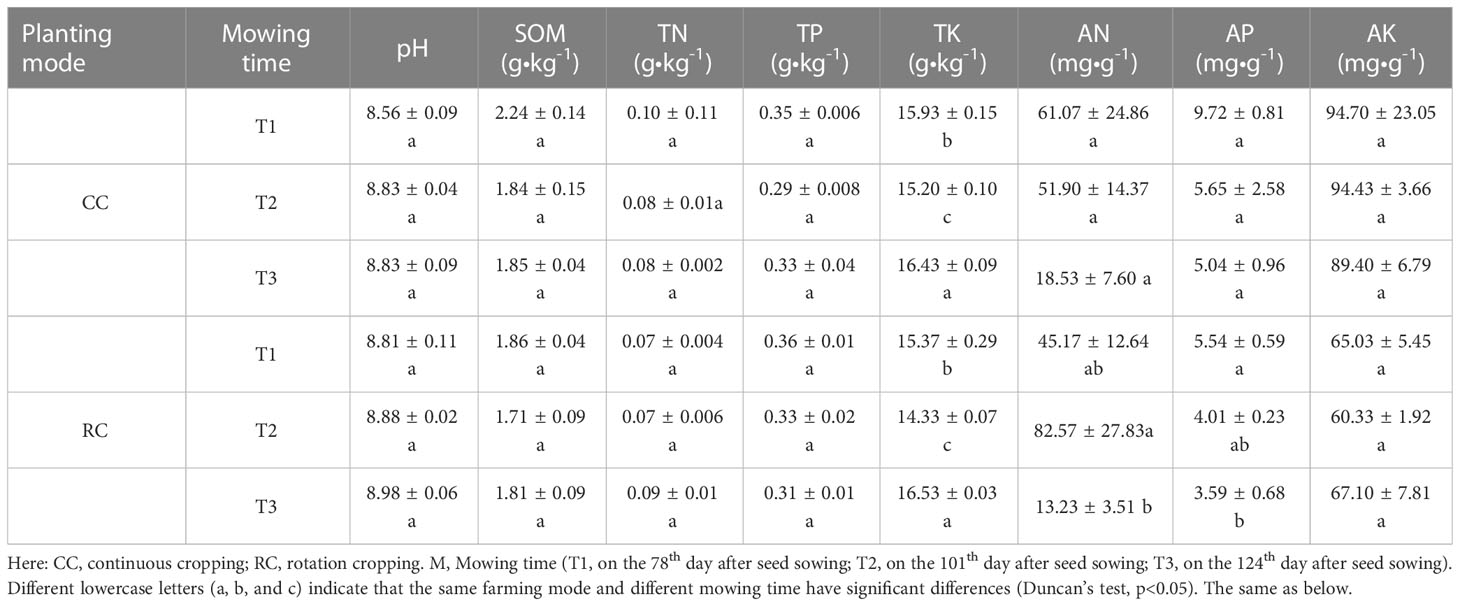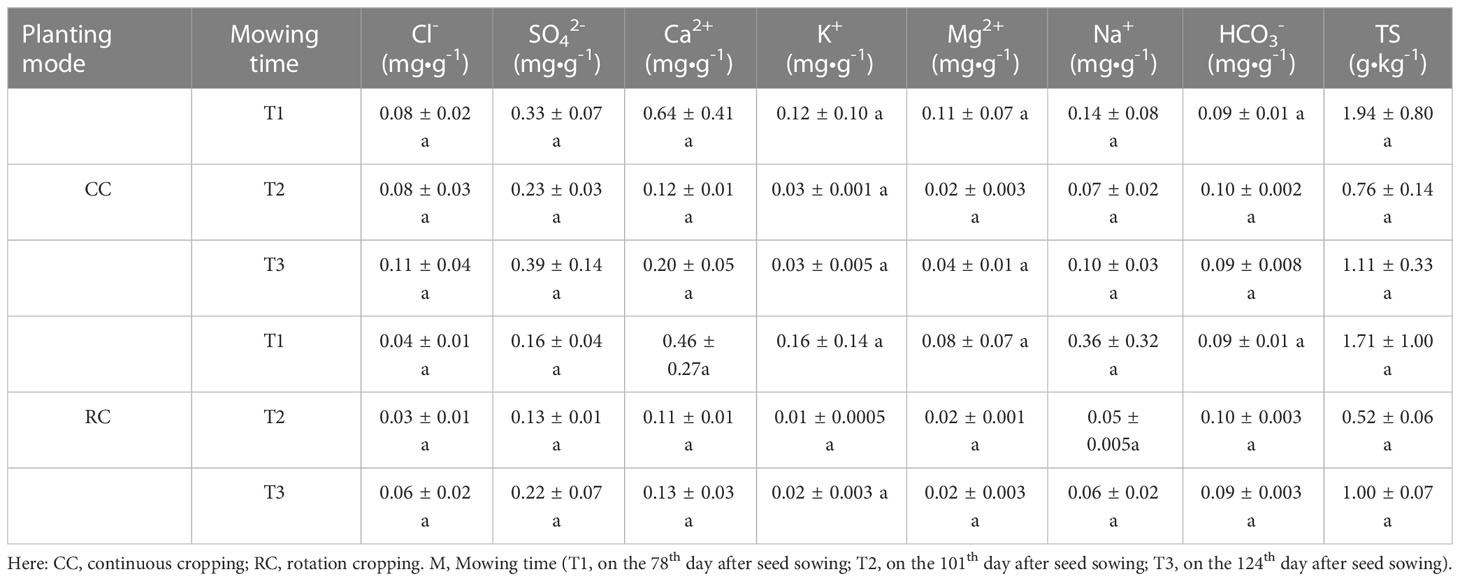- 1State Key Laboratory of Desert and Oasis Ecology, Xinjiang Institute of Ecology and Geography, Chinese Academy of Sciences, Urumqi, China
- 2Xinjiang Key Laboratory of Desert Plant Roots Ecology and Vegetation Restoration, Xinjiang Institute of Ecology and Geography, Chinese Academy of Sciences, Urumqi, China
- 3Cele National Station of Observation and Research for Desert-Grassland Ecosystems, Cele, China
- 4University of Chinese Academy of Sciences, Beijing, China
- 5College of Ecology and Environmental, Xinjiang University, Urumqi, China
Revealing the complex relationships between management practices, crop growth, forage nutritive value and soil quality will facilitate the development of more sustainable agricultural and livestock production systems. Cyperus esculentus is known as the king of oil crops and high-quality forage. However, there is little information about the effects of different planting modes {continuous cropping (CC)/rotation cropping (RC)} and initial mowing time on the plant nutrient accumulation and forage nutritive value. Here, in a field experiment, we designed two planting patterns, C. esculentus CC and C. esculentus - wheat RC. The leaves, tubers, roots, and soil samples were collected at three mowing time (on the 78th, 101th, and 124th days after seed sowing). Results revealed that RC significantly increased the total nitrogen (TN) and potassium (TK) content of the tuber (p<0.05), while significantly decreased the TN, total phosphorus (TP), crude protein (CP), and acid detergent fiber (ADF) contents of the leaves. Under the CC pattern, the TN, TP, and TK content of roots increased significantly on the 78th days after seed sowing, and the TK content of tubers increased significantly. Under the RC pattern, the ether extract (EE) content of tubers increased significantly on the 124th days after seed sowing, while the CP and TN content of leaves decreased significantly. Correlation analysis showed that soil pH was negatively correlated with TN content in leaves, tubers, and roots. The structural equation model showed that the soil pH directly affected the plant nutrient accumulation and forage nutritive value (β=0.68) via regulating these properties by changing soil available nutrients, anions, cations, and total nutrients. Overall, we propose that RC for C. esculentus-wheat is should not be recommended to maximize tubers and forage yield.
1 Introduction
Continuous cropping (CC) is the practice of growing the same crop on the same land for several years. This practice usually leads to the loss of soil nutrients and aggravation of pests and diseases, ultimately causing the decline in crop yield and quality (Xiong et al., 2015; Delang, 2018). In contrast, rotation cropping (RC), the scientific and orderly planting of different crops in the same field can improve the water use efficiency of crops (Zhou et al., 2011; Li et al., 2014; Peterson et al., 2020), balance soil nutrients, enhance soil functions, and increase crop yield (Larkin, 2003; Zhou et al., 2011; Moulin et al., 2015). However, the advantages of crop rotation are influenced by crop type, soil moisture and nutrient availability (Giacometti et al., 2021). For example, compared with non-leguminous crops, rotation with leguminous crops can effectively improve soil nitrogen (N) availability and system productivity (Ilyas et al., 2022). However, since different crops have different soil requirements (e.g. nutrient requirements), long-term rotation can accelerate soil nutrient loss and can intensify nutrient competition between crops and microorganisms, which adversely affects the yield of the two crops in rotation (Brankatschk and Finkbeiner, 2015). Therefore, accurate assessment of the response of specific crops to CC and RC is crucial for farmers to choose suitable cropping strategies in terms of soil fertility and nutrients of different organs.
Crude protein (CP), ether extract (EE), acid detergent fiber (ADF), and neutral detergent fiber (NDF) are important indexes for evaluating forage nutritive value (Richman et al., 2015). Some studies have shown that the soluble sugar (SS) content in the rotation was significantly higher than in CC (Yang et al., 2010; Hou et al., 2013). Meanwhile, the research found that the RC significantly increased the contents of CP and EE, reduced the content of SS, and improved the quality of tubers (Ma and Han, 2000; Wang et al., 2017). Mowing is a common practice to increase forage efficiency and yield for livestock (Zhao et al., 2021). The effects of initial mowing time on grassland productivity have been extensively studied under different climatic and soil conditions (Donaghy et al., 2008; Binnie et al., 2010). For example, medium initial mowing (15 July to 15 August) increased total dry matter yield and nutritional value of Leymus chinensis (Trin.) Tzvel. in Songnen grassland, China (Zhao et al., 2021). On the contrary, the early (April) and late (May) mowing reduced the total yield of the forage sugarcane in the Amami Region of Kagoshima Prefecture, Japan (Sakaigaichi et al., 2010). These inconsistencies in forage yield and forage nutritive value were mainly due to the interaction of initial mowing time, grass species and geographical location.
Animal husbandry is a mainstay of economic development in arid and semi-arid regions, however it is suffering from inadequate forage production and supply due to water constraints (Blum, 2009; Jia et al., 2022). Therefore, it is of great significance to select crops that are more suitable for both forage yield, grain and oil supply under water shortage conditions to improve livestock production and may alleviate food crisis in arid and semi-arid areas. Meanwhile, the Cyperus esculentus is a grass like plant widely distributed in many northern temperate regions and is gaining popularity in China, India, Egypt and the United States as an energy crop (Arafat et al., 2009; Bamishaiye et al., 2010; De Castro et al., 2015; Ayeni, 2022). Its aboveground parts (leaves) are used as forage, and its belowground parts are edible tubers with sweet taste with high levels of protein, fatty acids and starch, that make it a potential alternative to wheat and soybeans in many countries (Sánchez-Zapata et al., 2012; Ahmed and Hussein, 2014; Codina-Torrella et al., 2015; Ayeni, 2022). However, to our best knowledge, there is a little information on the nutritive value of the above- and under-ground parts of C. esculentus in respond to different planting modes (CC vs RC) and initial mowing time, even though it has been cultivated for many years in the desert oasis transition zone (Tan et al., 2022; Zhang et al., 2022).
Therefore, to research the understanding of response mechanisms to planting modes in C. esculentus is timely. Herein, we designed a field study containing two dependent treatments, two planting modes (CC vs RC) and three initial mowing time (on the 78th, 101th, and 124th days after seed sowing). Total nitrogen (TN), total phosphorus (TP), and total potassium (TK) contents in leaves, tubers, and roots were used to evaluate the nutrients of C. esculentus, CP, EE, and NDF contents in leaves, and EE, CP, and ADF in tubers were determined to characterize the above- and belowground nutritive value of C. esculentus, respectively. Our objectives were to (i) elucidate the influences of planting modes and initial mowing time on nutrient content and forage nutritive value of C. esculentus, and (ii) identify the factors affecting the nutrient content and forage nutritive value of C. esculentus. These attempts will provide a reference for the management of C. esculentus in the desert oasis transition zone.
2 Material and methods
2.1 Site description and experiment design
This experiment was carried out at Shache farm in Xinjiang (38.41° N, 77.24° E). The region has a warm temperate continental climate. The mean annual temperature, precipitation, and evaporation are 11.6°C, 53.3 mm, and 2246 mm, respectively. The frost-free period is 225 days and average temperature is above 10°C for the whole year (Arzigul and Xianmixinuer, 2017).
Our experiment was established on May 2018. The background of soil physicochemical properties in both CC and RC plots was similar, pH 8.87, soil organic matter (SOM) 2.527 g·kg-1, TN 0.093 g·kg-1, TP 0.325 g·kg-1, TK 16.133 g·kg-1, available nitrogen (AN) 18.677 mg·kg-1, the available phosphorus (AP) 4.260 mg·kg-1, the available potassium (AK) 50.867 mg·kg-1. After wheat harvest in May, the seeds of “fengchan No. 2”, a variety of C. esculentus, were sown simultaneously in the CC and RC treatments at the end of May by using a drop planter using 75 kg (seed)·hm-2 with the density of 20 × 35 cm (plant spacing × row spacing). The planting density was 142,860 plants·hm-2. The N, P, K fertilizer were dissolved in water and dripped to the root during the whole growth period every year. In each year, the first time of drip irrigation was carried out on the 30th day after the emergence of seedlings, and then six times at 15-day intervals. Before the final harvest (end of September) every year, the dosage of water and fertilizer was 6500 m3·hm-2 water, 335 kg·hm-2 N-fertilizer (urea, 46% N), 218 kg·hm-2 P-fertilizer (monoammonium phosphate, 10% N; 50% P2O5), and 68 kg·hm-2 K- fertilizer (potassium sulphate, 50% K2O).
Our sampling work was conducted on the 78th day after seed sowing. In each planting mode, three 10 × 5 m plots, 5 m apart, were set at each mowing time (on the 78th, 101th, and 124th days after seed sowing). In each plots, three 50 × 50 cm quadrats along the diagonal were set to collect plant (leaves, roots, and tubers) samples. Five topsoil (0~30 cm) samples along the diagonal in each plots were collected and mixed to prepare one sample to determine the soil physicochemical properties.
2.2 Measurement of plant nutrient content
The leaves, tubers, and roots were washed with running water and dried in an oven (65°C) until the constant weight was used to obtain biomass. These dry matters were powdered in a vibratory disc mill (RS200, Retsch GmbH Inc., Haan, Germany). To subsequent determination of nutrient content and quality of different organs after passing through a 0.42 mm sieve. The TN was measured using an elemental analyzer (2400 II CHN elemental analyzer; Perkin-Elmer, USA), TP was determined using the molybdenum-antimony anti-spectrophotometric method, and TK was determined by flame photometry (Bao, 2000). The EE was extracted by the Soxhlet extractor method, 2~5 g sample was weighed, adding anhydrous ether or petroleum ether was to 2/3 of the bottle content volume, heated in a water bath, so that ether or petroleum ether was continuously refluxed and extracted for 6~12 h. The CP content was determined by the Kjeldahl nitrogen determination method, 2~5g samples were weighed, and 0.5 g copper sulfate and 10 mL sulfuric acid were added. The content of ADF and NDF was determined by Fan’s detergent fiber analysis method (Li, 2000). 2g samples were accurately weighed and divided into two parts, one of which was added with 100 mL neutral detergent. Another 1 g sample was added with 100 mL acid detergent. Boil in 5~10 min, and keep boiling for 60 min. After boiling, remove the straight beaker, pour the solution in the beaker into the known weight glass heap installed on the filter bottle for filtration, remove all the residue in the beaker, and rinse the glass heap and residue with boiling water until the filtrate is neutral. Rinse twice with 20 mL acetone, and suction filtration. The glass pile was placed in a 105°C oven for 2 h and then cooled in a dryer for 30 min.
2.3 Measurement of soil physicochemical properties
Soil samples were air-dried after the removal of roots. TN, TP, TK, AN, AP, AK, and pH were determined after passing through a 2 mm sieve. The value of pH was evaluated by a PHS-3C digital pH meter in a 1:5 soil-water ratio suspension (IQ 150, IQ Scientific Instruments, CA, USA). The TN content was determined by using the CuSO4–Se powder diffusion method (Hooper and Vitousek, 1998). The Mo-Sb and Van-Mo-yellow colorimetry methods were applied to detect TP content (Lu et al., 2015). The TK content was determined by using molybdenum‐antimony colorimetry (Lu et al., 2015). Additionally, soil available N was tested using 2‐M KCl extracts by AA3‐automated flow injection analysis (Bran + Luebbe GmbH, Norderstedt, Germany); available P was extracted using 0.5 M NaHCO3, and available K was measured by the NH4OAc method (Neff et al., 2005; Warra et al., 2015). Soil organic matter (SOM) was determined by the wetoxidation technique. Total salt (TS) content and salt ion content were extracted with soil extract (soil and water ratio 5:1). The TS content was determined by using the conductivity method. The HCO3-, Cl-, SO42-, Ca2+, Mg2+, K+, and Na+ contents were measured according to the mothed of Bao (2000) and Lu (1999). Ca2+, Mg2+, K+, and Na+ were determined by plasma spectrometer with the test solution prepared by three acid mixture (1 mL 60% HClO4, 6 mL HNO3) digestion method (IRIS-ICP, TJA Ltd, USA). HCO3-, Cl-, and SO42- were determined by chemical titration.
2.4 Statistical analyses
All statistical analyses were conducted in the R v4.1.0 (R Core Team, 2018). Most of the results were visualized using the ‘ggplot2 package’. Two-way ANOVA was used to analyze the independent and interaction effects of CC/RC and mowing time on soil properties and nutrient content and forage nutritive value of C. esculentus. Duncan’s method was used for multiple comparisons (α=0.05), and the significance level was 0.05, expressed as mean ± standard error (SE, n = 3). T-test was used to analyze and compare the differences between different tillage patterns (CC and RC) at the same mowing time. Correlation analysis of soil properties, nutrient content, and forage nutritive value was computed and visualized by using the ‘psych package’ and ‘corrplot package’. The causal relationships between soil properties, nutrient content and forage nutritive value of C. esculentus were explored by the structural equation model using Amos-24 software.
3 Results
3.1 Soil physicochemical properties
The pH value, SOM, TK, and AP contents in soil were independently influenced by both planting pattern (CC/RC) and mowing time, while the AN and AK contents were independently influenced by mowing time and planting pattern, respectively (p<0.05, Table 1). The interaction of these factors significantly changed TK content (p<0.05). However, soil TN and TP contents were not significantly affected by planting mode and mowing time (p>0.05). The RC mode significantly increased soil pH, while significantly reduced SOM, TK, AP, and AK contents (p<0.05, Table 2). With the postponement of mowing time, soil pH gradually increased, while SOM and AP gradually decreased. The AN content showed a significant decline at the end of mowing time (Table 2). Except for Cl- and SO2-4 that reduced in RC mode (Table 3), the other parameters of soil salinity did not respond significantly to planting pattern and mowing time (Table 4).

Table 1 Two-way ANOVA analysis of effects of the planting mode and mowing time on soil physicochemical properties.

Table 4 Two-way ANOVA analysis of effects of the planting mode and mowing time on soil physicochemical properties.
3.2 The nutrient content and allocation of the leaves, tubers, and roots
Planting mode and mowing time independently and interactively impacted the TN and TP contents in leaves and tubers, that is, the response of these two elements in the specific organ to mowing times varied from CC and RC systems (p<0.05, Table 5). For example, RC significantly decreased foliar N and P content, while these two elements in tubers were improve in CC systems (p<0.05, Figure 1). No interaction between planting mode and mowing time on nutrient was observed in roots (Table 5; Figure 1).

Table 5 Two-way ANOVA analysis of effects of the planting mode and mowing time on the physicochemical property of the leaves, tubers, and roots of C. esculentus.
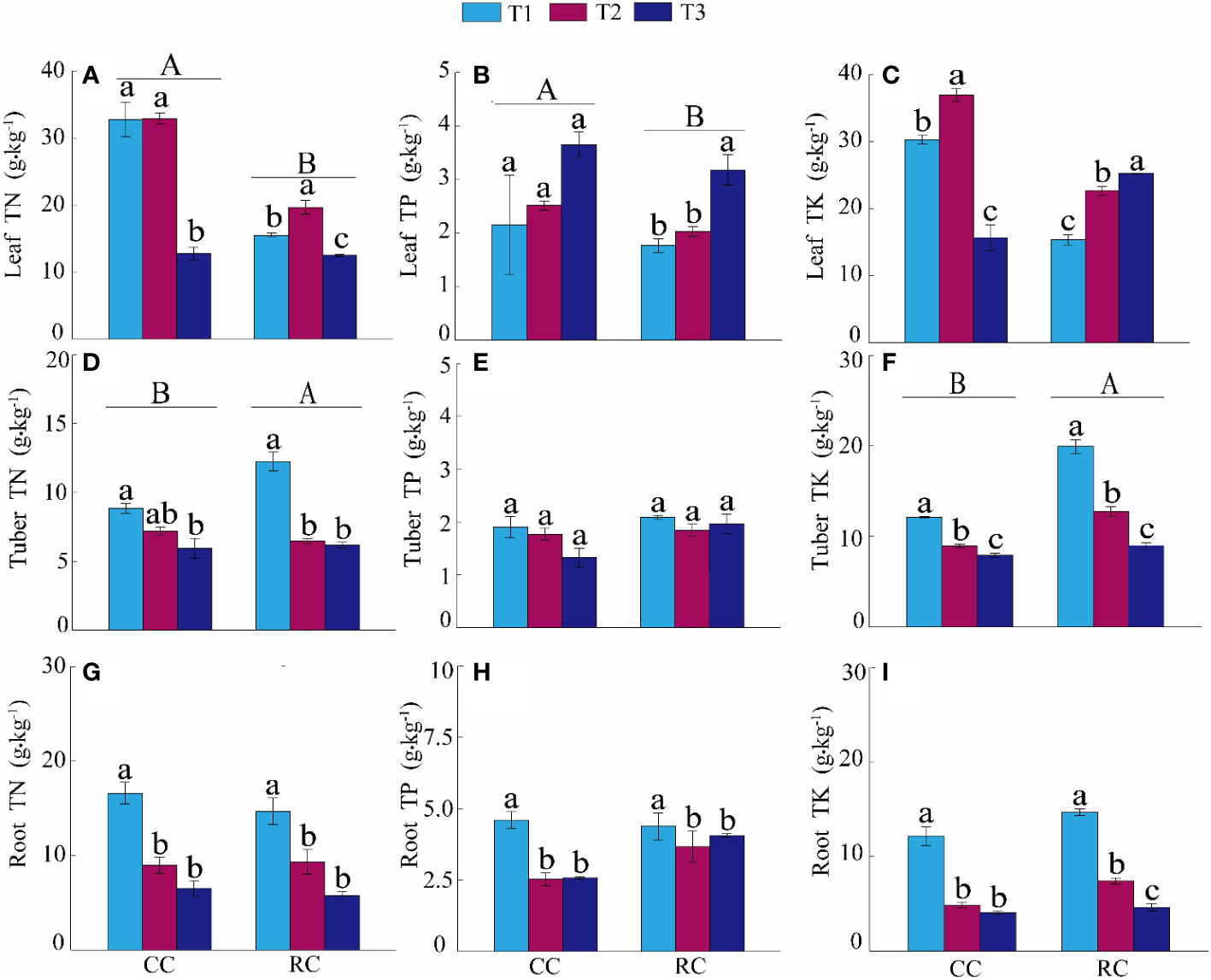
Figure 1 Effects of the continuous cropping (CC)/rotation cropping (RC) and mowing time on [A (total nitrogen (TN)], B [total phosphorus (TP)], and C [total potassium (TK)] of the leaves, [ D (total nitrogen (TN)], E [total phosphorus (TP)], and F [total potassium (TK)] of the tubers, and [ G (total nitrogen (TN)], H [total phosphorus (TP)], and I [total potassium (TK)] of the roots.
3.3 The forage nutritive value of the leaves, tubers, and roots
Planting mode interacted with mowing time significantly altered the foliar CP and NDF contents and the CP contents in tubers (p<0.05, Table 6). Foliar ADF content was significantly influenced by planting modes. Planting modes and mowing time independently affected EE content in tubers, while they did not exert significant effects on foliar EE content (p>0.05). Compared with CC system, RC had a significantly adverse effect on the accumulation of CP and ADF in leaves, and CP in tubers (Figures 2A, B, E). On the 124th day after seed sowing, more ADF and NDF accumulated in leaves, while the CP contents in leaves and tubers showed a lower level than those at other periods (Figure 2).

Table 6 Two-way ANOVA analysis of effects of the planting mode and mowing time on the forage nutritive value of the leaves of C. esculentus.
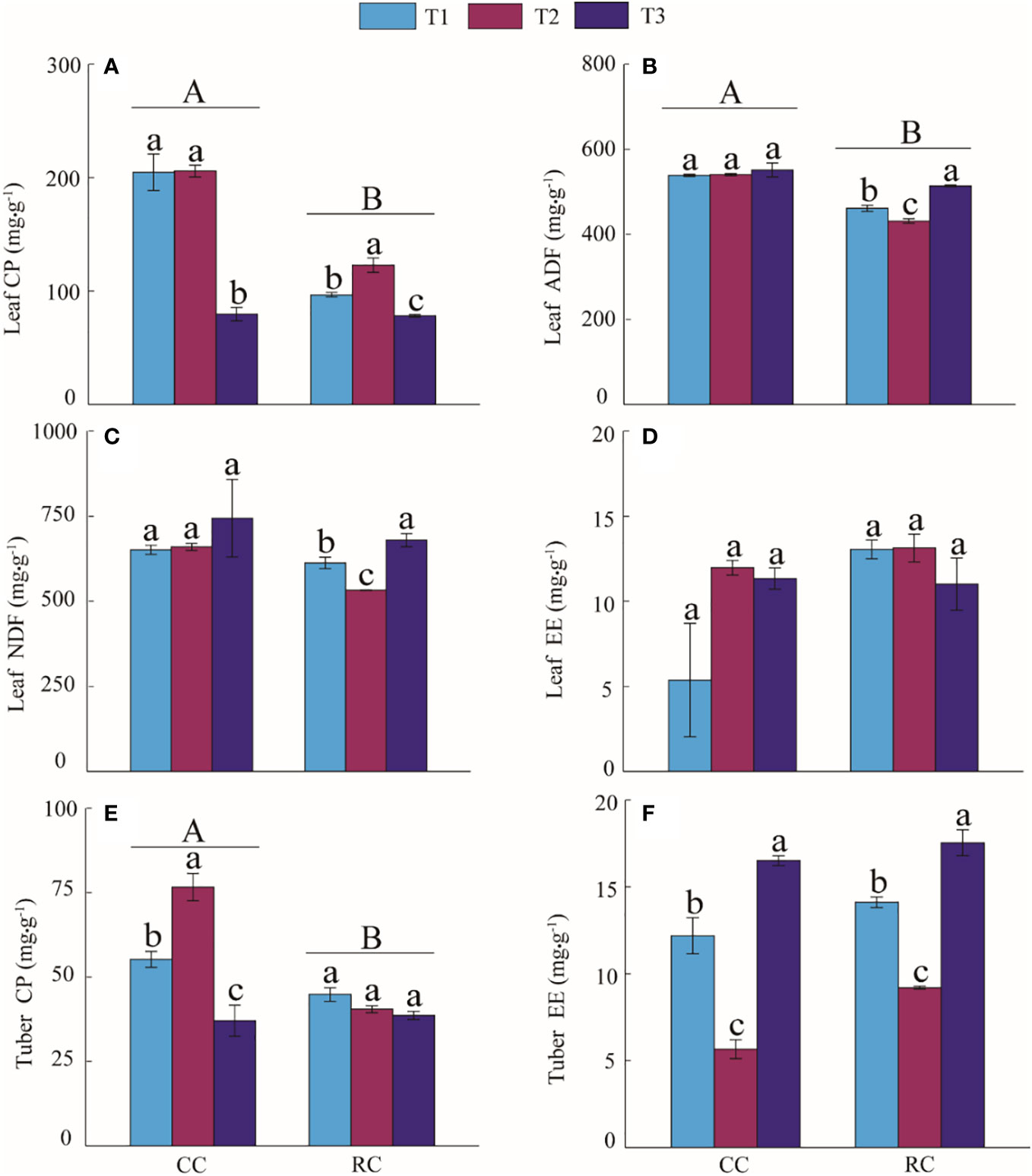
Figure 2 Effects of the continuous cropping (CC)/rotation cropping (RC) and mowing time on [A (crude protein (CP)], B [acid detergent fiber (ADF)], C [neutral detergent fiber (NDF)], and D [ether extract (EE)], contents of the leaves and E [crude protein (CP)] and F [ether extract (EE)], contents of the tubers.
3.4 The relationships between the nutrient content and forage nutritive value of leaves, tubers, roots, and soil factors
The Pearson’s correlation analysis showed that foliar forage nutritive value (i.e., CP, EE, ADF, and NDF) had a significant correlation with some soil factors, such as SOM, AN, AP, AK, and Ca2+ (p<0.05, Figure 3). The EE content of tubers was negatively influenced by AN, while positively affected by TK (p<0.05). Compared with other elements, plant TP was slightly affected by soil factors, only having a significant positive correlation with TN in the tuber and a significant negative correlation with AK in the root (p<0.05).
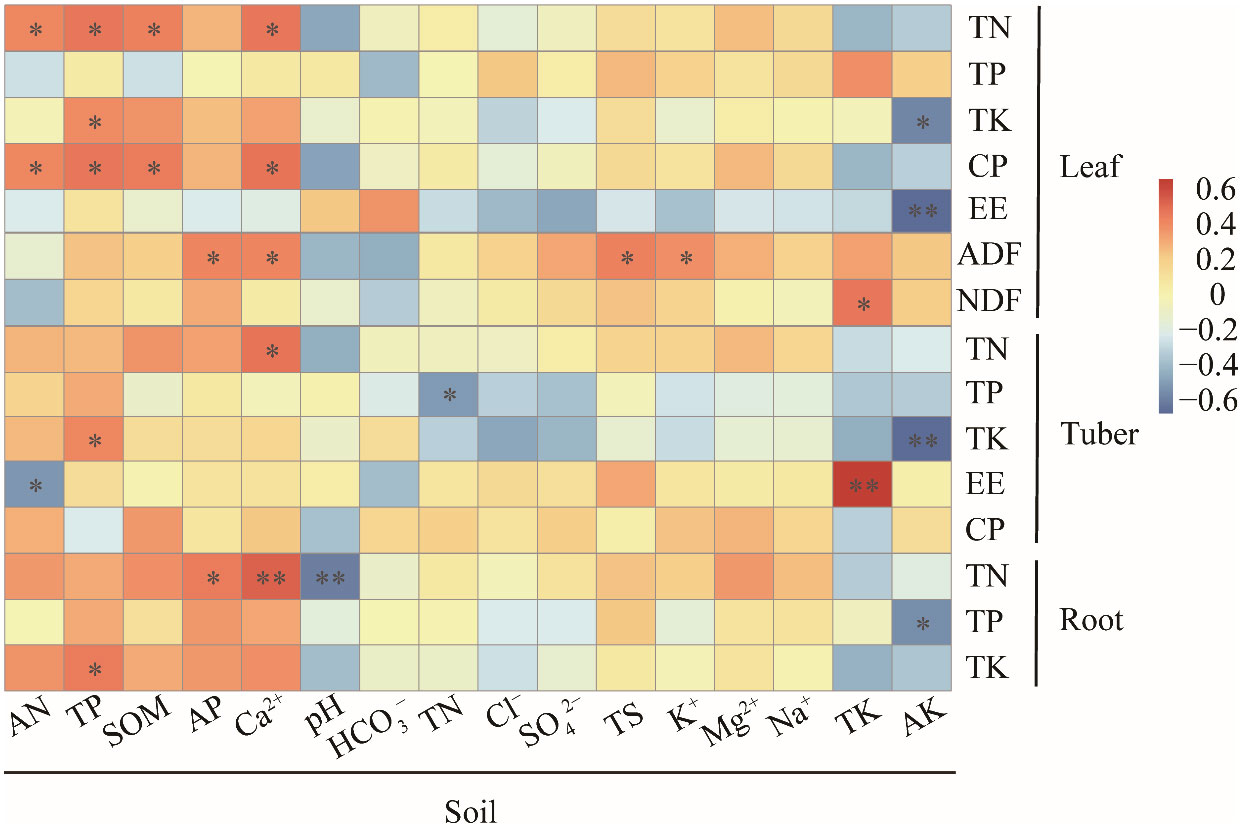
Figure 3 Correlation analysis of leaves, tubers, roots, and soil factors. Here: SOM, soil organic matter; TN, total nitrogen; TP, total phosphorus; TK, total potassium; AN, available nitrogen; AP, the available phosphorus; AK, the available potassium; TS, Total salt; EE, ether extract; CP, Crude protein; ADF, acid detergent fiber; NDF, neutral detergent fiber. *p < 0.05; **p < 0.01.
The structural equation model revealed an important role of soil pH in regulating the accumulation of nutrients and forage nutritive value of the leaves and tubers. Soil pH, base ions, cations, and available and total nutrients exhibited 26% of the variation in nutrient and nutritive value of the leaves and tubers (X2 =2.403, p=0.301, Figure 4). Among them, the nutrient and nutritive value of leaves and tubers were dominantly and directly affected by soil pH, with a standardized direct effect of 0.68 (Figure 4). Additionally, soil pH indirectly affected the nutrients and nutritive value of the leaves and tubers by changing the available nutrients, anions, cations, and total nutrients in soil.
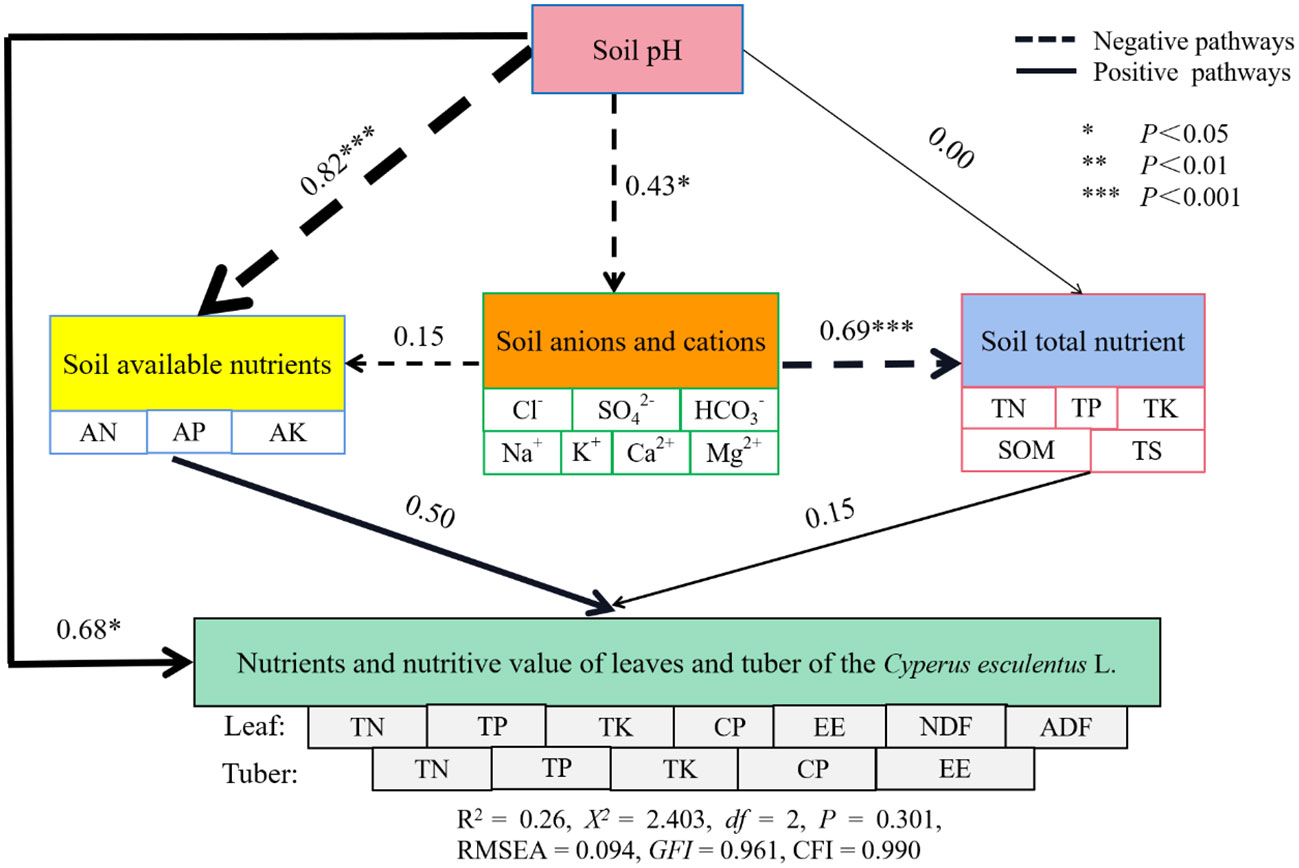
Figure 4 The structural equation model of effects of the continuous cropping (CC)/rotation cropping (RC) on nutrient content and forage nutritive value of leaves and tubers. Here: The principal component (soil available nutrients, soil anions and cations, soil total nutrients, and nutrient and forage nutritive value of the leaves and tubers) first axis data are reported in Table 7.
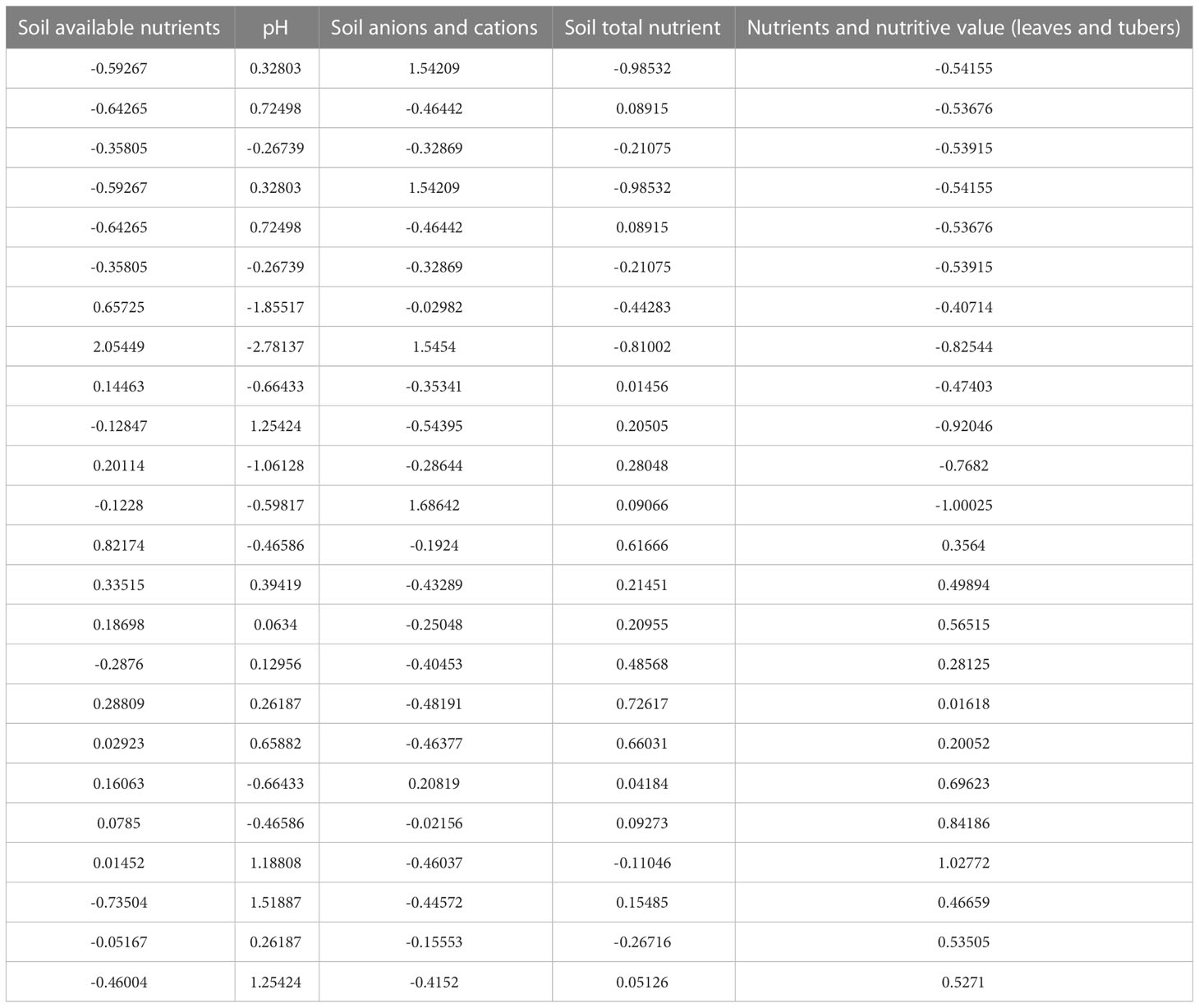
Table 7 The principal component first axis data (soil available nutrients, soil anions and cations, soil total nutrients, and nutrient and forage nutritive value of the leaves and tubers).
4 Discussion
In this study, the nutrient and nutritional value of leaves and tubers, as well as the nutrient content of soil were determined and analyzed by selecting different planting patterns (RC and CC) and setting three mowing time. Finally, it was found that RC was not conducive to the growth and development of C. esculentus. On the 124th day after seed sowing, the EE content of tubers was increased, which indirectly increased its oil yield.
4.1 The effects of RC on plant nutrient accumulation and forage nutritive value
Crop rotation in present study exerted a negative effect of on foliar nutrient (e.g., TN, and TP) accumulation and forage nutritive value of C. esculentus (Figure 1A, B), inconsistent with the promoting effect of rotation found by previous studies (Sun et al., 2018; Ding et al., 2019; Lenssen et al., 2020). Two possible factors explain this inconsistency. On the one hand, the root distribution of C. esculentus and wheat highly overlapped in topsoil (~30 cm depth), which intensifies competition for soil nutrients (e.g., SOM, TK, AP, and AK contents, Table 2), although these two crops did not exist at the same time (Duan et al., 2019). On the other hand, the root exudates of the two species are inconsistent, and the microbial communities absorbed and enriched are also different, resulting in changes in soil physical and chemical properties and soil structure (Li et al., 2014). Therefore, it affects the seed germination and plant growth of the same or heterogeneous plants, especially for heterogeneous plants (Lendzemo et al., 2009).
N is a key element in the formation of nutrient value of forage. With mowing time, AN in soil decreased continuously, which hindered the formation of CP in leaves and reduced the forage quality (Table 2; Figure 1). First, wheat is an important allelopathic crop and some substances (such as benzoxazinoids and polyphenols) in its root exudates can inhibit the growth of its neighboring heterologous species (Lendzemo et al., 2009; Hussain et al., 2022). The accumulation of these allelopathic substances in the soil may inhibit the growth of C. esculentus. Second, during the growth and development of plants, root exudates can not only affect the absorption and transport of nutrient availability in the soil, but also adsorb some heavy metal elements around the root system to affect the crop rotation next year (Sun et al., 2018).
Indeed, C. esculentus has been treated as a weed in many countries (Devries, 1991; Werle et al., 2022). Conversely, the rotation showed a positive effect on C. esculentus by enhancing nutrient (e.g., TN and TK) accumulation in tubers (Figure 1D, F). Tubers are a key reproductive organ of C. esculentus and its nutrient content determines the initial conditions of germination (Ozcan et al., 2021). Nutrient allocation to reproductive organs is an important stress adaptation strategy to increase the survival of offspring (Coello and Martinez-Barajas, 2016). Based on the above discussion, on the one hand, wheat should be carefully introduced into the rotation system of C. esculentus, while leguminous crops (e.g., Alfalfa and soybeans) may be preferred due to better nitrogen fixation and soil improvement ability. On the other hand, the application of organic manure is also a more effective way to overcome the obstacles caused by RC in this study by improving soil quality (Alburquerque et al., 2012).
4.2 Relationship between plant nutrient content and forage nutritive value and soil properties
Our study uncovered that soil pH is the vital factor influencing plant nutrient content and forage nutritive value (Figure 4). Previous studies have proved that pH can not only change the decomposition process of SOM and nutrient availability, but also directly affect the reaction rates of enzymes associated with biochemical reactions and soil microbial activities, thus it can regulate crop growth by affecting soil properties (Dick et al., 2000; Guo et al., 2010). The soil AK and sodium ion content are less, resulting in a relative excess of soil H+, leading to soil acidification (Dick et al., 2000; Ozcan et al., 2021). However, RC changed the soil pH value, making the soil TN, soil TP, soil TK, and soil available nutrients variation significantly, which affected the accumulation of nutrients and nutritional quality of the leaf and tuber (Guo et al., 2010). Higher soil pH was observed in RC systems than in CC (Table 3), that may be due to much higher uptake of nitrate (NO- 3) and compensatory secretion of OH- by crops in the rotation system (Alvey et al., 2001). Higher level of Mg2+ may also contribute to the higher pH in RC system (Table 3). In our study, soil pH exerted a direct and indirect impact on plant nutrient accumulation and forage nutritive value by regulating the available nutrients, anions, cations, and total nutrients in soil (Figure 4). Therefore, a range of physical, chemical, and biological processes may be involved in the negative effects of rotations on nutrient accumulation and forage nutritive value. These processes will be explored by introducing key indicators such as plant physiology, microbial activity and soil enzyme activity in our future studies.
5 Conclusions
In conclusion, RC, irrespective of mowing time, exerted a positive effect on nutrient accumulation (e.g., total nitrogen, and potassium) in tubers, but a negative influence on nutrient accumulation (total nitrogen, phosphorus, and potassium) in leaves and roots, and their nutritive value (evaluated by CP, EE, ADF, and NDF). Soil properties, especially pH, may explain the variation of the performance of C. esculentus growing in CC and RC. The plant nutrient accumulation and forage nutritive value were directly affected by soil pH and were indirectly regulated by the variations in soil available nutrients, anions, cations, and total nutrients induced by soil pH. Therefore, RC for C. esculentus is not a good planting mode at any mowing time in terms of plant nutrient accumulation and forage nutritive value, likely due to degraded soil quality induced by nutrient competition between crops. For the intensive cultivation of C. esculentus, organic manure supplementation and rotation with legumes may overcome these adverse effects caused by rotation with wheat that will be explored in our future research.
Data availability statement
The original contributions presented in the study are included in the article/supplementary material. Further inquiries can be directed to the corresponding authors.
Author contributions
Conceptualization: YD, YZ, FZ. Data curation: YD, YZ and XC. Formal analysis: YD, YZ, and ZZ. Funding acquisition: FZ. Investigation: YD, YZ, XC, FZ. Methodology: YD, YZ and AU. Project administration: FZ. Resources: FZ. Software: YD, YZ and ZZ. Supervision: FZ. Validation: FZ, YD, YZ, WI and ZZ. Writing -original draft: YD, YZ. Writing - review and editing: YD, YZ, XL, FZ, WI, ZZ. All authors contributed to the article and approved the submitted version.
Funding
Key Research and Development Project of Xinjiang Uygur Autonomous Region (No. 2022B02040-1) and National Key Research and Development Project of China (No. 2019YFC0507603).
Conflict of interest
The authors declare that the research was conducted in the absence of any commercial or financial relationships that could be construed as a potential conflict of interest.
Publisher’s note
All claims expressed in this article are solely those of the authors and do not necessarily represent those of their affiliated organizations, or those of the publisher, the editors and the reviewers. Any product that may be evaluated in this article, or claim that may be made by its manufacturer, is not guaranteed or endorsed by the publisher.
References
Ahmed, Z. S., Hussein, A. M. S. (2014). Exploring the suitability of incorporating tiger nut flour as novel ingredients in gluten free biscuit. Polish J. Food Nutr. Sci. 64 (1), 27–33. doi: 10.2478/v10222–012–0087–z
Alburquerque, J. A., de la Fuente, C., Campoy, M., Carrasco, L., Najera, I., Baixauli, C., et al. (2012). Agricultural use of digestate for horticultural crop production and improvement of soil properties. Eur. J. Agron. 43, 119–128. doi: 10.1016/j.eja.2012.06.001
Alvey, S., Bagayoko, M., Neumann, G., Buerkert, A. (2001). Cereal/legume rotations affect chemical properties and biological activities in two West African soils. Plant Soil 231, 45–54. doi: 10.1023/A:1010386800937
Arafat, S. M., Gaafar, A. M., Basuny, A. M., Nassef, S. L. (2009). Chufa tubers (Cyperus esculentus l.): As a new source of food. World Appl. Sci. J. 7 (2), 151–156.
Arzigul, Y. S., Xianmixinuer, K. L. M. (2017). Characteristics of agricultural climate resources and analysis of main meteorological disasters in shache county. Modern Agric. Sci. Technol. 20, 200.
Ayeni, A. O. (2022). Hoop house and field evaluation of tigernut (Cyperus esculentus l. var. sativus boeck) selections in new Jersey, USA. Plants 11 (7), 897. doi: 10.3390/plants11070897
Bamishaiye, E. I., Muhammad, N. O., Bamishaiye, O. M. (2010). Assessment of biological value of tiger nut (Cyperus esculentus) tuber oil meal-based diet in rats. Ann. Biol. Res. 1, 274–280. doi: 10.1007/978-3-030-12473-1_11
Bao, S. D. (2000). Analysis of soil and agrochemistry. 3 ed (Beijing: China Agriculture Press), 25–200.
Binnie, R. C., Chestnutt, D. M. B., Murdoch, J. C. (2010). The effect of time of initial defoliation and height of defoliation on the productivity of perennial ryegrass swards. Grass Forage Sci. 35 (4), 267–273. doi: 10.1111/j.1365-2494.1980.tb01522.x
Blum, A. (2009). Effective use of water (EUW) and not water-use efficiency (WUE) is the target of crop yield improvement under drought stress. Field Crops Res. 112 (2-3), 119–123. doi: 10.1016/j.fcr.2009.03.009
Brankatschk, G., Finkbeiner, M. (2015). Modeling crop rotation in agricultural LCAs — challenges and potential solutions. Agric. Syst. 138, 66–76. doi: 10.1016/j.agsy.2015.05.008
Codina-Torrella, I., Guamis, B., Trujillo, A. J. (2015). Characterization and comparison of tiger nuts (Cyperus esculentus l.) from different geographical origin: Physico-chemical characteristics and protein fractionation. Ind. Crops Products 65, 406–414. doi: 10.1016/j.indcrop.2014.11.007
Coello, P., Martinez-Barajas, E. (2016). Changes in nutrient distribution are part of the mechanism that promotes seed development under severe nutrient restriction. Plant Physiol. Biochem. 99, 21–26. doi: 10.1016/j.plaphy.2015.11.022
De Castro, O., Gargiulo, R., Del Guacchio, E., Caputo, P., De Luca, P. (2015). A molecular survey concerning the origin of Cyperus esculentus (Cyperaceae, poales): two sides of the same coin (weed vs. crop). Ann. Bot. 115, 733–745. doi: 10.1093/aob/mcv001
Delang, C. O. (2018). The consenquences of soil degradation in China: A review. Geoscape 12, 92–103. doi: 10.2478/geosc-2018-0010
Devries, F. T. (1991). Chufa (Cyperus esculentus, cyperaceae) - a weedy cultivar or a cultivated weed. Econ. Bot. 45 (1), 27–37. doi: 10.1007/bf02860047
Dick, W. A., Cheng, L., Wang, P. (2000). Soil acid and alkaline phosphatase activity as pH adjustment indicators. Soil Biol. Biochem. 32 (13), 1915–1919. doi: 10.1016/s0038-0717(00)00166-8
Ding, D. Y., Feng, H., Zhao, Y., Hill, R. L., Yan, H., Chen, H. X., et al. (2019). Effects of continuous plastic mulching on crop growth in a winter wheat-summer maize rotation system on the loess plateau of China. Agric. For. Meteorol. 271, 385–397. doi: 10.1016/j.agrformet.2019.03.013
Donaghy, D. J., Turner, L. R., Adamczewski, K. A. (2008). Effect of defoliation management on water-soluble carbohydrate energy reserves, dry matter yields, and herbage quality of tall fescue. Agron. J. 100 (1), 122–127. doi: 10.2134/agronj2007.0016
Duan, Z. P., Gan, Y. W., Wang, B. J., Hao, X. D., Xu, W. L., Zhang, W., et al. (2019). Interspecific interaction alters root morphology in young walnut/wheat agroforestry systems in northwest China. Agroforestry Syst. 93, 419–434. doi: 10.1007/s10457-017-0133-2
Giacometti, C., Mazzon, M., Cavani, L., Triberti, L., Baldoni, G., Ciavatta, C., et al. (2021). Rotation and fertilization effects on soil quality and yields in a long term field experiment. Agronomy 11, 636. doi: 10.3390/agronomy11040636
Guo, J. H., Liu, X. J., Zhang, Y., Shen, J. L., Han, W. X., Zhang, W. F., et al. (2010). Significant acidification in major chinese croplands. Science 327 (5968), 1008–1010. doi: 10.1126/science.1182570
Hooper, D. U., Vitousek, P. M. (1998). Effects of plant composition and diversity on nutrient cycling. Ecol. Monogr. 68 (1), 121–149. doi: 10.2307/2657146
Hou, J. J., Zhao, G. Q., Jiao, T., Chai, J. K., Wang, H. X. (2013). Evaluation on adaptability of six avena varieties in xiahe county, gansu province. Grassland Turf 33 (2), 26–32. doi: 10.13817/j.cnki.cyycp.2013.02.006
Hussain, M. I., Vieites-Álvarez, Y., Otero, P., Prieto, M. A., Simal-Gandara, J., Reigosa, M. J., et al. (2022). Weed pressure determines the chemical profile of wheat (Triticum aestivum l.) and its allelochemicals potential. Pest Manage. Sci. 78, 1605–1619. doi: 10.1002/ps.6779
Ilyas, N., Yang, Y., Zhang, C., Singh, R. P., Yu, Q., Yuan, Y., et al. (2022). Temporal dynamics and variation in the alfalfa root nodule and rhizosphere microbial communities of coastal sand and lawn soil. J. Plant Interact. 17, 173–182. doi: 10.1080/17429145.2021.2024899
Jia, X., Zhang, Z., Wang, Y. (2022). Forage yield, canopy characteristics, and radiation interception of ten alfalfa varieties in an arid environment. Plants 11 (9), 1112. doi: 10.3390/plants11091112
Larkin, R. P. (2003). Characterization of soil microbial communities under different potato cropping systems by microbial population dynamics, substrate utilization, and fatty acid profiles. Soil Biol. Biochem. 35 (11), 1451–1466. doi: 10.1016/s0038-0717(03)00240-2
Lendzemo, V., Kuyper, T. W., Urban, A., Vegvari, G., Puschenreiter, M., Schickmann, S., et al. (2009). The arbuscular mycorrhizal host status of plants can not be linked with the Striga seed-germination-activity of plant root exudates. J. Plant Dis. Prot. 116 (2), 86–89. doi: 10.1007/BF03356291
Lenssen, A. W., Sainju, U. M., Allen, B. L., Stevens, W. B., Jabro, J. D. (2020). Diversified crop rotation and management system influence durum yield and quality. Agron. J. 112 (5), 4407–4419. doi: 10.1002/agj2.20311
Li, H. S. (2000). Experimental principles and techniques of plant physiology and biochemistry (Beijing: Higher Education Press).
Li, X., Ding, C., Hua, K., Zhang, T. L., Zhang, Y. N., Zhao, L., et al. (2014). Soil sickness of peanuts is attributable to modifications in soil microbes induced by peanut root exudates rather than to direct allelopathy. Soil Biol. Biochem. 78, 149–159. doi: 10.1016/j.soilbio.2014.07.019
Lu, R. K. (1999). Soil agrochemical analysis (Beijing: China Agricultural Science Technology Press), 80–89.
Lu, X., Yan, Y., Sun, J., Zhang, X., Chen, Y., Wang, X., et al. (2015). Carbon, nitrogen, and phosphorus storage in alpine grassland ecosystems of Tibet: Effects of grazing exclusion. Ecol. Evol. 19)5, 4492–4504. doi: 10.1002/ece3.1732
Ma, C. H., Han, J. G. (2000). The research of the best on mowing time of unicast and oats and vetch mixed grassland. Grass Feeding Livestock 3, 42–45. doi: 10.16863/j.cnki.1003-6377.2000.03.015
Moulin, A. P., Buckley, K. E., Volkmar, K. (2015). Soil quality as affected by amendments in bean-potato rotations. Can. J. Soil Sci. 91 (4), 533–542. doi: 10.4141/cjss10011
Neff, J. C., Reynolds, R. L., Belnap, J., Lamothe, P. (2005). Multi-decadal impacts of grazing on soil physical and biogeochemical properties in southeast Utah. Ecol. Appl. 15 (1), 87–95. doi: 10.1890/04-0268
Ozcan, M. M., Ghafoor, K., AlJuhaimi, F., Uslu, N., Babiker, E. E., Ahmed, I. A. M. (2021). Influence of germination on bioactive properties, phytochemicals and mineral contents of tigernut (Cyperus esculentus l.) tuber and oils. J. Food Measurement Characterization 15, 3580–3589. doi: 10.1007/s11694-021-00929-3
Peterson, G. A., Westfall, D. G., Schipanski, M. E., Fonte, S. J. (2020). Soil and crop management systems that ameliorate damage caused by decades of dryland agroecosystem mismanagement. Agron. J. 112 (5), 3227–3238. doi: 10.1002/agj2.20257
R Core Team (2018). R: A Language and Environment for Statistical Computing. Publisher Foundation for Statistical Computing, Vienna, Austria URL: https://www.r-project.org/.
Richman, S. E., Leafloor, J. O., Karasov, W. H., Mcwilliams, S. R. (2015). Ecological implications of reduced forage quality on growth and survival of sympatric geese. J. Anim. Ecol. 84 (1), 284–298. doi: 10.1111/1365-2656.12270
Sakaigaichi, T., Tarumoto, Y., Hattori, I., Kamiya, M., Yoshida, H. (2010). Effect of dense planting on the growth and yield of forage sugarcane variety, KRFo93-1, in planting cane. Japanese J. Crop Sci. 79 (1), 1–9. doi: 10.1626/jcs.83.356
Sánchez-Zapata, E., Fernández-López, J., Angel Pérez-Alvarez, J. (2012). Tiger nut (Cyperus esculentus) commercialization: health aspects, composition, properties, and food applications. Compr. Rev. Food Sci. Food Saf. 11 (4), 366–377. doi: 10.1111/j.1541-4337.2012.00190.x
Sun, L., Wang, S. L., Zhang, Y. J., Li, J., Wang, X. L., Wang, R., et al. (2018). Conservation agriculture based on crop rotation and tillage in the semi-arid loess plateau, China: Effects on crop yield and soil water use. Agric. Ecosyst. Environ. 251, 67–77. doi: 10.1016/j.agee.2017.09.011
Tan, J., Wu, X., Zeng, F., Li, X., Feng, M., Liao, G., et al. (2022). Effects of crop residue on wind erosion due to dust storms in hotan prefecture, xinjiang, China. Soil Tillage Res. 221, 105387. doi: 10.1016/j.still.2022.105387
Wang, Y. M., Lei, Y. F., Wei, Z. W. (2017). Effects of different rotation modes on yield, quality of silage corn, and soil fertility. J. Nucl. Agric. Sci. 31 (9), 1803–1810. doi: 10.11869/j.issn.100-8551.2017.09.1803
Warra, H. H., Ahmed, M. A., Nicolau, M. D. (2015). Impact of land cover changes and topography on soil quality in the kasso catchment, bale mountains of southeastern Ethiopia. Singapore J. Trop. Geogr. 36 (3), 357–375. doi: 10.1111/sjtg.12124
Werle, I. S., Castro, E., Pucci, C., Soni Chakraborty, B., Broderick, S., Tseng, T. M. (2022). Identification of weed-suppressive tomato cultivars for weed management. Plants 11 (3), 411. doi: 10.3390/plants11030411
Xiong, W., Li, Z., Liu, H., Xue, C., Zhang, R. F., Wu, H. S., et al. (2015). The effect of long-term continuous cropping of black pepper on soil bacterial communities as determined by 454 pyrosequencing. PloS One 10 (8), e0136946. doi: 10.1371/journal.pone.0136946
Yang, J., Shen, Y. Y., Nan, Z. B., Gao, C. Y., Niu, Y. N., Wang, X. Z., et al. (2010). Effects of conservation tillage on crop yield and carbon pool management index on top soil within a maize-wheat-soy rotation system in the loess plateau. Acta Prataculturae Sin. 19 (1), 75–82.
Zhang, S., Li, P., Wei, Z., Cheng, Y., Liu, J., Yang, Y., et al. (2022). Cyperus (Cyperus esculentus l.): A review of its compositions, medical efficacy, antibacterial activity and allelopathic potentials. Plants 11 (9), 1127. doi: 10.3390/plants11091127
Zhao, C. Z., Li, Q., Cheng, L., Zhong, R. Z. (2021). Effects of mowing regimes on forage yield and crude protein of Leymus chinensis (Trin.) tzvel in songnen grassland. Grassland Sci. 67, 275–284. doi: 10.1111/grs.12314
Keywords: continuous/rotation cropping, mowing time, relative abundance, nutrient content, structural equation model
Citation: Du Y, Zhang Y, Chai X, Li X, Ullah A, Islam W, Zhang Z and Zeng F (2023) Effects of different tillage systems and mowing time on nutrient accumulation and forage nutritive value of Cyperus esculentus. Front. Plant Sci. 14:1162572. doi: 10.3389/fpls.2023.1162572
Received: 09 February 2023; Accepted: 23 March 2023;
Published: 14 April 2023.
Edited by:
Amanullah, University of Agriculture, Peshawar, PakistanReviewed by:
Roxana Vidican, University of Agricultural Sciences and Veterinary Medicine of Cluj-Napoca, RomaniaSanjay Singh Rathore, Indian Agricultural Research Institute (ICAR), India
Copyright © 2023 Du, Zhang, Chai, Li, Ullah, Islam, Zhang and Zeng. This is an open-access article distributed under the terms of the Creative Commons Attribution License (CC BY). The use, distribution or reproduction in other forums is permitted, provided the original author(s) and the copyright owner(s) are credited and that the original publication in this journal is cited, in accordance with accepted academic practice. No use, distribution or reproduction is permitted which does not comply with these terms.
*Correspondence: Waqar Islam, RGRvYXBzaWFsQHlhaG9vLmNvbQ==; Zhihao Zhang, emhhbmd6aEBtcy54amIuYWMuY24=; Fanjiang Zeng, emVuZ2ZqQG1zLnhqYi5hYy5jbg==
†These authors have contributed equally to this work
 Yi Du1,2,3,4†
Yi Du1,2,3,4† Xutian Chai
Xutian Chai Xiangyi Li
Xiangyi Li Abd Ullah
Abd Ullah Waqar Islam
Waqar Islam Zhihao Zhang
Zhihao Zhang Fanjiang Zeng
Fanjiang Zeng